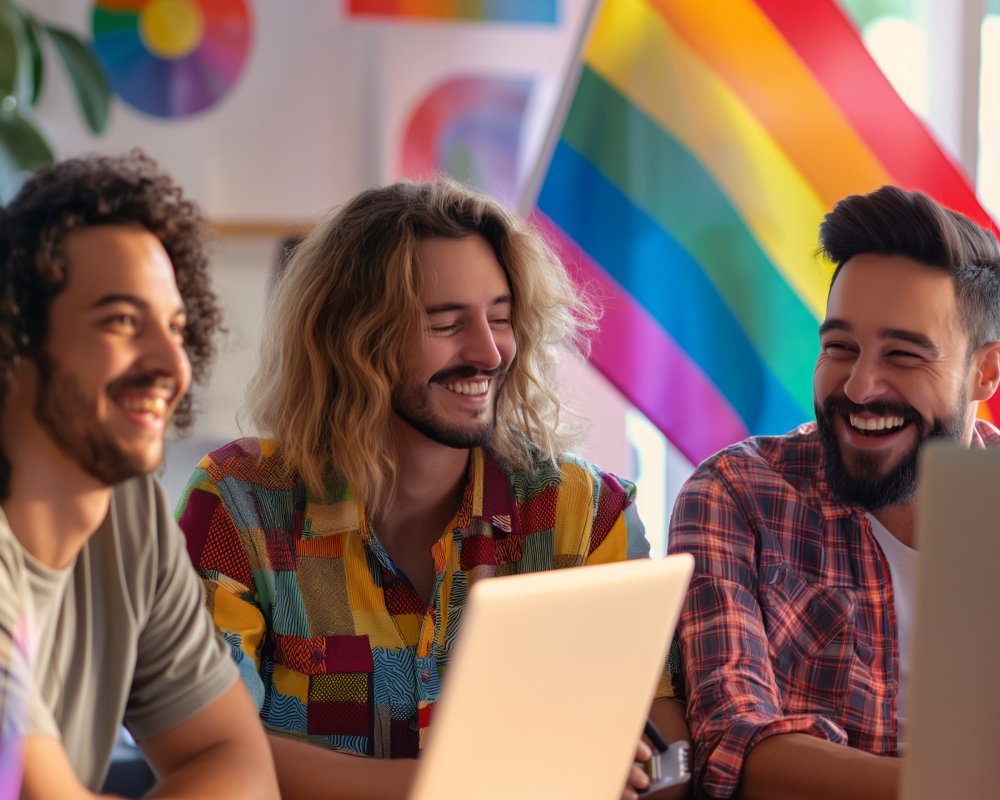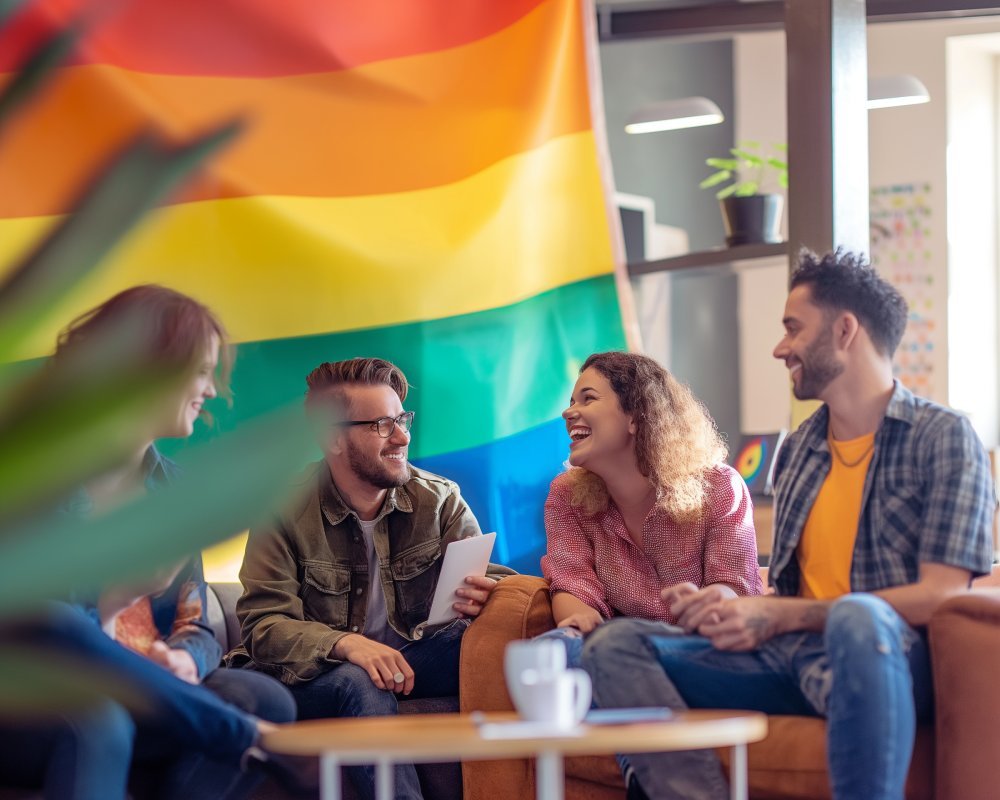
Can You Be Gay and Religious? – Amidst the colorful tapestry of human identity lies a question that has intrigued and confounded many: Can You Be Gay and Religious? Countless individuals navigate the intersection of their queer identity and their spiritual beliefs, often finding themselves at a crossroads. This duality can pose challenges, as for some, religious doctrines have traditionally opposed LGBTQ+ identities. For others, faith is a source of strength and solace, enabling them to embrace their identity fully. This blog, hosted by Gay Thrive LGBTQ+ Marketing Agency, aims to delve into this intricate narrative, exploring how LGBTQ+ individuals reconcile their sexuality with their spirituality. By tackling this topic, we seek to shed light on personal experiences, debunk myths, and offer tips on finding harmony between these seemingly discordant elements. Let’s embark on a journey that celebrates diversity not as a barrier but as a bridge, fostering understanding and acceptance in our communities.
The Historical Tension Between Religion and LGBTQ+ Identities
Historically, many religious institutions have held conservative views on LGBTQ+ issues, often labeling non-heteronormative identities as sinful or contrary to divine plans. This tension has its roots in traditional interpretations of religious texts which, over time, have been used to justify exclusionary practices. For gay, lesbian, transgender, queer, and bi individuals, this has often resulted in spiritual alienation. Yet, it’s crucial to recognize that religion itself isn’t inherently oppressive; rather, it is human interpretations that can skew perceptions. Today, a growing number of religious communities and leaders are reevaluating these interpretations, fostering environments where LGBTQ+ members are welcomed and celebrated. By examining these shifts, we can appreciate strides being made toward inclusivity and explore the nuanced question: Can You Be Gay and Religious?

Personal Stories: Real-Life Narratives on Faith and Sexuality
How do individuals reconcile their faith with their LGBTQ+ identity? The answer varies widely, reflecting a diverse range of personal experiences. Some find solace in faith, seeing it as a complement to their identity rather than a contradiction. These personal stories are not just tales of conflict but also of resilience, compassion, and acceptance. For some, leaving a religious institution becomes necessary to maintain their mental and emotional well-being. For others, reframing their understanding of spirituality allows for a harmonious coexistence of faith and identity. By sharing these stories, we aim to illuminate the varied paths one can traverse when confronted with the question, “Can You Be Gay and Religious?”
Advertisement · Scroll to continue
Recommended
Religious Inclusivity: Denominations Embracing LGBTQ+ Members
Many religious groups have embarked on a journey toward inclusivity, revisiting traditional doctrines and interpretations. Denominations like certain branches of Christianity, including the Episcopal Church and Unitarian Universalists, stand as beacons of LGBTQ+ acceptance. They recognize the sacredness of all individuals, regardless of their sexual orientation or gender identity. Moreover, reformative movements within other religions, such as progressive Judaism and some Islamic groups, are emerging, advocating for the rights and recognition of LGBTQ+ members. In examining such global shifts, we address the central question, Can You Be Gay and Religious? Here lies the proof that the answer is a resounding yes for many communities, where faith and identity coexist gracefully.

The Psychological Benefits of Merging Faith and Identity
The integration of one’s LGBTQ+ identity with their religious beliefs can yield significant psychological benefits. Religion and spirituality often provide a framework for meaning, offering comfort, hope, and a sense of belonging. For many gay, lesbian, transgender, queer, and bi individuals, maintaining this connection can enhance mental well-being and foster resilience against discrimination and prejudice. Studies suggest that individuals who successfully navigate this integration often report higher levels of life satisfaction and self-esteem. Delving into these benefits affirms that the question, Can You Be Gay and Religious? is not merely about coexistence but thriving harmony.
Challenges on the Journey: The Struggle for Acceptance
While strides towards inclusivity abound, the challenge of reconciling faith with LGBTQ+ identities is far from over. Many individuals continue to face resistance from conservative communities, familial rejection, or internal conflict. The fear of judgment or exclusion can deter people from exploring their spiritual sides fully. Addressing these struggles requires a collective effort from religious leaders, communities, and LGBTQ+ advocates. Ultimately, the question, Can You Be Gay and Religious? isn’t solely about personal reconciliation but also about reshaping societal narratives and fostering environments where acceptance is standard, not an exception.

Advertisement · Scroll to continue
Recommended
Practical Tips for Balancing Faith and LGBTQ+ Identity
For those seeking to reconcile their religious and LGBTQ+ identities, numerous strategies can facilitate this journey:
- Research Inclusive Communities: Seek out denominations or faith communities known for their LGBTQ+ acceptance.
- Engage in Open Dialogue: Initiate conversations with religious leaders who demonstrate progressive attitudes towards inclusion.
- Pursue Personal Reflection: Explore spiritual practices that resonate with your beliefs without compromising your identity.
- Connect with Support Networks: Join LGBTQ+ support groups within your religious community or externally.
These tips aim to offer practical pathways for those grappling with the question, Can You Be Gay and Religious?, highlighting that faith and identity can complement each other beautifully.
Reimagining a More Inclusive Future
As society becomes increasingly aware of the multiplicity of human identities, the future of religious inclusivity looks promising. Imagine a world where acceptance is ingrained in religious teachings, where young LGBTQ+ individuals grow up knowing they are cherished both by their faith and community. This vision is gradually taking shape as more religious organizations incorporate LGBTQ+ affirming policies and practices. Education, dialogue, and compassion are key to this transformation. By continuing to question, Can You Be Gay and Religious?, we challenge the status quo and pave the way for inclusivity and understanding.

The Role of the LGBTQ+ Community in Promoting Inclusivity
In addressing the intersection of religion and LGBTQ+ identities, the LGBTQ+ community plays a pivotal role. Advocacy and visibility efforts continue to challenge outdated stereotypes and urge religious communities to embrace inclusivity. Through collaboration with religious leaders and allies, the LGBTQ+ community advances dialogues that lead to broader acceptance and love. This active participation is vital in ensuring environments where the question, Can You Be Gay and Religious?, may transform into an obvious affirmation of yes, visible in daily experiences and community standards.
Finding Religious Leaders Who Support LGBTQ+ Rights
Identifying religious leaders who openly support LGBTQ+ rights can be instrumental in bridging faith with identity. Many clergy are vocal advocates for inclusion, using their platforms to champion equality. Engaging with these leaders can create welcoming environments for LGBTQ+ individuals. The presence of progressive religious figures highlights the tangible answer to the question, Can You Be Gay and Religious?, demonstrating that faith can indeed be a supportive and loving space for diverse identities.
Creating Safe Spaces within Religious Institutions
The creation of safe spaces within religious institutions is pivotal for fostering LGBTQ+ acceptance. By designating areas where open dialogue is encouraged and judgment is set aside, institutions can uphold the sanctity of all individuals. Safe spaces enable LGBTQ+ members to explore their spirituality freely, without fear of condemnation. They exemplify the affirmative answer to the question, Can You Be Gay and Religious?, showing that faith environments can adapt and nurture all believers.
Collaborating with Allies for Deeper Understanding
Collaboration with allies, both within and outside religious circles, is crucial for expanding understanding and acceptance of LGBTQ+ individuals in faith communities. Allies can offer support, lend their voices to advocacy efforts, and help bridge gaps between differing viewpoints. When working in tandem, allies and the LGBTQ+ community can facilitate dialogues that answer the question, Can You Be Gay and Religious?, positively and inclusively, championing the notion that faith and identity need not exist at odds.
Cultivating Resilience: Thriving Amidst Diversity
Ultimately, the journey of aligning faith with LGBTQ+ identity is one of personal resilience and growth. Despite historical challenges, many individuals find strength in exploring this duality, enriching their lives through a deeper understanding of self and spirituality. This resilience underscores the adaptability of human belief systems and the boundless capacity for love and acceptance. Answering the question, Can You Be Gay and Religious?, with a confident yes, highlights the celebratory nature of diverse identities thriving in shared humanity.
In conclusion, the quest to reconcile religious beliefs with LGBTQ+ identities is intricate, personal, and evolving. As reflected through history, personal narratives, and societal shifts, the question, Can You Be Gay and Religious?, not only has positive answers but also continues to inspire transformation and acceptance. By fostering open dialogues, embracing inclusivity, and championing resilience, we can create environments where faith and identity coexist in harmony. Together, we navigate this journey toward integration, enriching our communities with diversity and unity.
Advertisement · Scroll to continue

More Recommended
Top 20 Businesses Owned by Lesbian Women
Top 20 Businesses Owned by Lesbian Women – It highlights 20 real businesses owned by [...]
Ultimate Guide to NYC Pride 2025
Ultimate Guide to NYC Pride 2025 – NYC Pride is more than just a parade; [...]
Target Takes Aim at Gay Consumers with Inclusive Marketing Strategy
Target Takes Aim at Gay Consumers with Inclusive Marketing Strategy – Target Takes Aim at [...]
How do you build an inclusive workplace culture?
How do you build an inclusive workplace culture? – Creating an inclusive workplace culture requires [...]
Inclusive Marketing: The Influence of Lesbian-Owned Brands on Brand Messaging
Inclusive Marketing: The Influence of Lesbian-Owned Brands on Brand Messaging Lesbians have long been a [...]
SEO Tips for Gay-Owned Businesses: Boosting Online Visibility
SEO Tips for Gay-Owned Businesses: Boosting Online Visibility – In today’s digital world, having a [...]
Why Were LGBTQ+ Rights Pushed in the 1990s?
Why Were LGBTQ+ Rights Pushed in the 1990s? The 1990s marked a transformative decade for [...]
The Future of LGBTQ+ Marketing: Trends to Watch
The Future of LGBTQ+ Marketing: Trends to Watch – The landscape of marketing is constantly [...]
Love Wins: How Gay-Friendly Businesses are Embracing Equality in Marketing
Love Wins: How Gay-Friendly Businesses are Embracing Equality in Marketing – As a society, we [...]